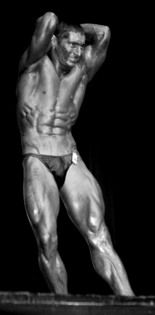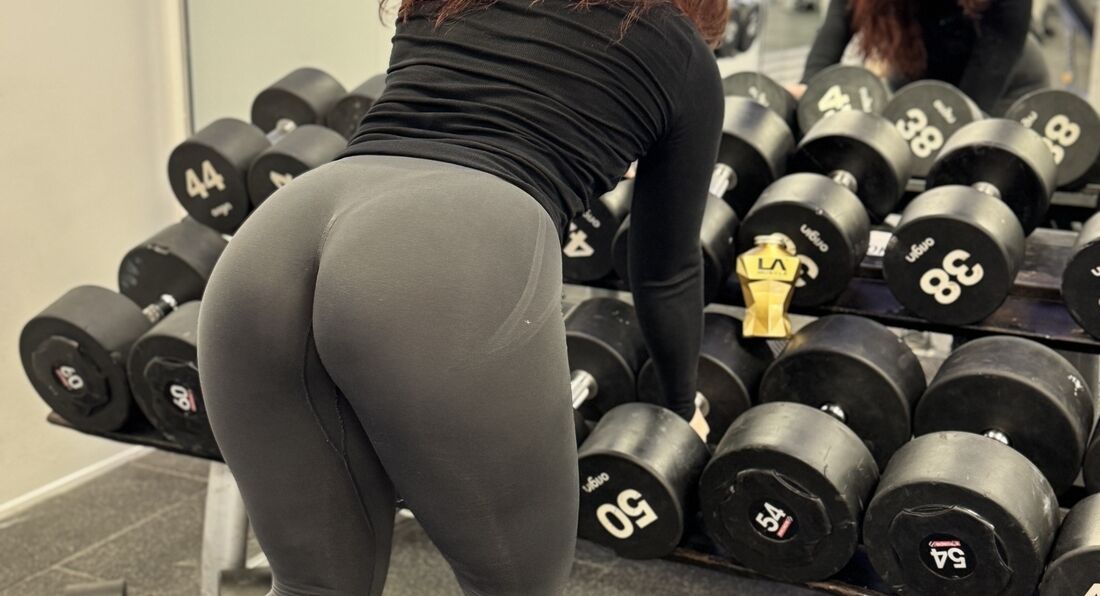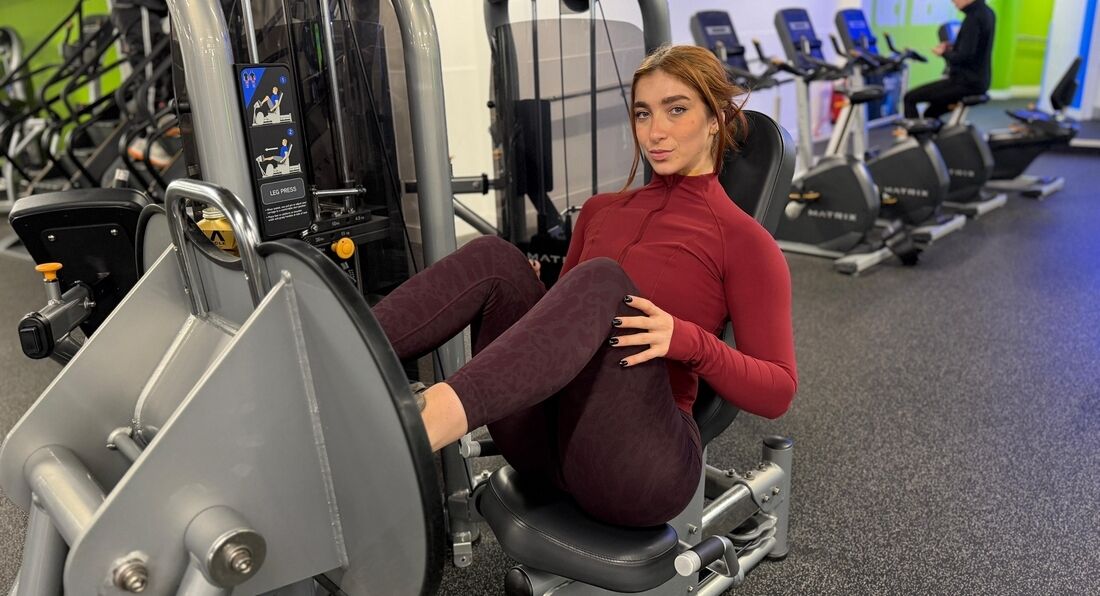The Knowledge > How To Build Muscle >
Sunday, 18th January 2009
Stable Training v Unstable Training
An article by Glen Danbury on the pros & cons on both training methods and exactly "which" will help build a better body
By LA Muscle on 18.01.2009 11:23 am
Stable vs Unstable Training; a Balanced View
By Glen Danbury MSc, Bsc (Hons), BNBF Central Overall Winner
Enter any modern fitness centre and you would think that you have just arrived at the national academy for trapeze artists and circus performers. Left and right you will see people balancing on large inflatable objects or steps which wobble enough to break every health and safety edict.
Without a doubt the last half a decade has seen an explosion in stability and 'core strengthening' devices. This has pleased the personal trainers no end as it makes it easier to sell something unusual. However many hardcore training aficionados look upon these devices like all other 'get fit in five minutes a day' gimmicks, basically a waste of time and just cluttering valuable gym floor space that could be used for shuttle runs or another squat rack. As with any anything there is benefits and drawbacks of using both stable and unstable training protocols and choosing the most appropriate activity depending upon your goals, level of ability and phase of training is paramount. Considering this the various benefits and inherent flaws of stability type training will explored within this article so as to provide you with the knowledge to choose an exercise which will bring about maximum efficacy to your training.
As with any anything there is benefits and drawbacks of using both stable and unstable training protocols and choosing the most appropriate activity depending upon your goals, level of ability and phase of training is paramount. Considering this the various benefits and inherent flaws of stability type training will explored within this article so as to provide you with the knowledge to choose an exercise which will bring about maximum efficacy to your training.
Pros vs Cons
Stable exercises such as machines offer a couple of benefits to those new to exercise and those seeking to gain maximum tension within a very specific muscle or grouping of muscles. With these exercises a guided path is often present and as such the prime movers are allowed to exert maximal tension to produce a desired movement. The opposite can be said of unstable exercises the movement will require large amounts of work by other muscles to control the movement (muscles which are termed neutralisers and fixators), this causes a reduction in the amount of tension that can be developed by the prime movers for a variety of reasons. The first reason is to do with simple physics, if the prime mover applies more force than the fixators and neutralisers can produce (termed as stabiliser muscles from now on) there will be a dissipation of the said.
This is due to Newton's third law of motion which states for every action there will be an equal and opposite action. What this means is as you push forward there will be a force pushing you back and if the force holding you in place isn't enough to keep you in place the force going forward will have to be reduced or you will be moved instead. A good example for this would be someone pushing against a wall, if the person is standing upon concrete and has good traction they are likely to stay motionless or push the wall over if they have enough force. However if they are standing upon loose shingle its likely that as they push against the wall their feet will slide backwards as the forces keeping there feet in place is insufficient to hold them in place.
Taking this example back to the gym, if the person is on an unstable surface and they produce more force than the muscles which are holding them in place they are likely to fall of their balance board or inflatable, this is usually accompanied by a round of applause from the hardcore brigade as well as the gym manager searching for the customers original disclaimer.
 Usually this will not happen as the individual either exerts maximal force from the stabilising muscles with an accompanying inhibition of the prime mover through the nervous system exerting inhibitory post synaptic potential -IPSP, which is a inhibitory signal sent from the nervous system to cause hyperpolarisation and make signals harder to be sent to the prime mover to contract.
Usually this will not happen as the individual either exerts maximal force from the stabilising muscles with an accompanying inhibition of the prime mover through the nervous system exerting inhibitory post synaptic potential -IPSP, which is a inhibitory signal sent from the nervous system to cause hyperpolarisation and make signals harder to be sent to the prime mover to contract.
This can be looked at from two perspectives, firstly there will be maximal tension developed within the stabiliser muscles which will lead to a training effect in those muscles. This is important for those individuals who need to produce force in an open environment where they need to stabilise the body as they exert force - most sports. However if the individual trains in this manner all the time they will generally lack overall maximal strength as the loads that can employed with these types of training modalities is usually insufficient to develop strength within the prime movers. As depicted in fig 1 with decreased stability there is a corresponding decrease in maximal tension developed within the prime mover. This is self evident by using simple power-lifting techniques to create a more rigid stable position to lift from, by having a good set up and keeping rigid you will be able to lift heavier weights.

In opposition to this the level of tension developed within the fixators and neutralisers is heightened due to the increase in instability.
As such those who solely train on stability devices will have a strong core and usually a fairly impressive six pack yet will be weak in the extremities and have a distinct lack of hypertrophy in the distal portions (lets be honest a girly physique at best). Individuals who train on machines as their sole training modality will often be the opposite, carrying sufficient hypertrophy and able to display great shows of maximal strength in the gym environment but will be unable to display this same ability on the field - all show and no go.
Continuum of stability
So what's the answer, should you train with instability devices or in a more controlled environment? Depending upon your weaknesses and training goals you would obviously use a combination of instability type modalities along with fixed path stabile exercises. Luckily there is a large amount of exercises out there and many of these exercises offer the benefits of both worlds whilst avoiding the trainee habituating to the drawbacks from either. The reason for this is that exercises don't just fall into the black and white categories of unstable or guided path but rather a continuum from one to the other.
Fig 2 shows the continuum and how exercises vary in their level of instability

As can be seen there is a range from machine exercises through to free weights on all the way to the current balls and wobble boards that have gained popularity recently. This continuum is not perfect as certain free weight exercises done bilaterally may require more stabilisation than a unilateral exercise. To give a better understanding each category is explored with examples below
Machine based exercises

Depending upon how exercises are performed on a machine will also affect how it can shift along the continuum. For example if you where to perform a lat pull-down standing up without the knee pads for support more muscles would be required to hold you in place.
Bilateral free weight exercises.

Again how you perform the exercise will have an effect upon how stability is required. For example performing an overhead press seated requires less work from fixators and neutralisers than performing the same exercises standing.
Unilateral free weight exercises
Perform an exercise with the load in one arm or side creates a force which will cause the body to tilt or rotate if a compensatory force is not generated by the said neutraliser and fixators for the movement. This is evident with one arm overhead dumbbell presses compared to the conventional two arm overhead press. Obviously the nature of the movement must be considered, for example a heavy maximal squat will require more work from the core than a one arm lateral raise. In this case a bilateral free weight exercise is more unstable than a unilateral exercise because of the load employed, which is often forgotten by many trainers or it's intentionally avoided in case their clients actually do some work and break a sweat - gasp, shock horror.
Uneven loaded exercises
This is typified by what's being currently described as 'strongman' training, where odd objects or unconventional weights are lifted. There are a variety of different objects that can be lifted and each present there own unique training load. Odd objects such as rocks, anvils and such like will present a challenge in that you will not be able to stay in a uniform position to lift the weight. As such there will be different forces applied bilaterally and most of the trunk will have to work to stop rotation and allow a clean lift. This usually work well for building grip strength as you often have to work overtime to hold onto the object and will have to use a variety of gripping strengths from crushing, pinching and gripping to maintain your hold.
Objects such as sand bags or water filled drums and kegs present a different stimulus altogether as they are dynamic forces in action. As you lift these objects they move requiring you to stabilise and recruits different muscles throughout the entire range of motion as the objects centre of gravity shifts and you adjust your posture accordingly. These unstable exercises have one thing in common- usually your feet are in contact with the ground and the instability arises from the load, this is different to the next category of exercises.

The weird and the wonderful. This incorporates all the latest novelty gadgets seen in most fitness centres from Swiss balls, air discs, wobble boards and all the other balance style training devices currently on the market. During these exercises there is the novel stimulus of the surface moving as opposed to the load moving. What this means is that the stabilisation occurs more in the lower body and midsection than around the joint actually being worked. For example during the overhead press whilst standing upon a wobble board the smaller fixators and neutralisers of the ankle and knee will be working to maintain the lower bodies fixed position upon the device and although there is greater work for the fixators and neutralisers of the shoulder the greatest training effect will be occurring for the lower body as this requires the most stabilisation.
What about specificity and the ground not moving?
Often several coaches and trainers will say the device are not sport specific for field athletes as the ground doesn't move for them rather they move over the ground and as such the devices will not translate to any real improvements in on field performance. However this is like saying that lying down to do bench presses will not enable an athlete to produce greater on field displays of upper body strength. The point is that exercises shouldn't match motor patterns of actual on field skills or performance, rather they should provide improvements in neurological adaptations (intramuscular coordination) and provide morphological adaptations (increased muscle mass, cellular energy pools etc) that aid in performance of that skill. Skill practice alone will enable the athlete to improve intermuscular coordination. Practicing similar skills with weights usually just results in faulty engrams for the skill in question.
As such the question needs to be asked by the coach or trainer whether increasing intramuscular coordination or causing a morphological adaptation within the stabilising muscles in question will aid the athlete to perform better, if it does then use the damn device.
When push comes to shove
When all is said and done its obvious both stable and unstable training protocols have a place in the training of an athlete, which style will give you the greatest performance increase depends upon a variety of factors such as sports needs and the athletes strengths and weakness, as such a needs analysis should be sort for each athlete.
As with most things the truth lays in the middle and training modalities are no different. If you took three athletes, one performing squats on a wobble board, one free bar squatting and one squatting using a machine, the athlete using the free bar will beat the athlete using a wobble board as they can display more force from their prime movers and like wise this same athlete will beat the athlete using a machine as they have sufficient strength in their fixators and neutralisers to display their strength compared to the machine user. Obviously in terms of training economy the free bar squat would rule, however there is a second take home message - as an athlete you better be squatting!





























